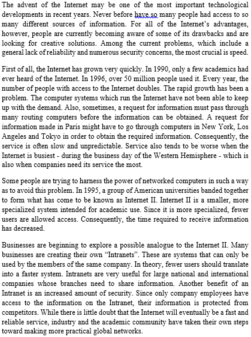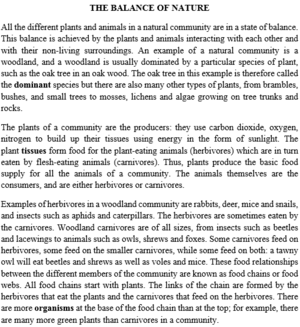Read the following passage and mark the letter A, B, C or D to indicate the correct answer to each of the questions from 43 to 50.
It can be shown in facts and figures that cycling is the cheapest, most convenient, and most environmentally desirable term of transport in towns, but such cold calculations do not mean much on a frosty winter morning. The real appeal of cycling is that it is so enjoyable. It has none of the difficulties and tensions of other ways of traveling so you are more cheerful after a ride, even though the rush hour.
The first thing a non-cyclist says to you is: "But isn't it terribly dangerous?" It would be foolish to deny the danger of sharing the road with motor vehicles and it must be admitted that there are an alarming number of accidents involving cyclists. However, although police records indicate that the car driver is often to blame, the answer lies with the cyclist. It is possible to ride in such a way as to reduce risks to a minimum.
If you decide to join the thousands in Britain who are now returning to cycling as a cheap, satisfying form of transport your first problem will be trying to decide what bike to buy. Here are three simple rules for buying a bike:
1. Always buy the best you can afford. Of course there has to be a meeting point between what you would really like and economic reality, but aim as high as you can and you will get the benefit not only when you ride but also if you want to sell. Well-made bikes keep the value very well. And don't forget to include in your calculations the fact that you'll begin saving money on
fares and petrol the minute you leave the shop.
2. Get the best frame, the main structure of the bicycle, for your money as you can. Cheap brakes, wheels or gears can easily be replaced by more expensive ones, but the frame sets the upper limit on any transformation. You should allow for the possibility our cycling ambitions will grow with practice. When you begin, the four miles to work may the most you ever dream of, but after a few months a Sunday ride into the country begins to look more and more desirable. The best thing is to buy a bike just a little bit better than you think you'll need, and then grow into it. Otherwise, try to get a model that can be improved.
3.The fit is vital. Handlebars and seat height can be adjusted but you must get the right sized frame. On the whole it is best to get the largest size you can manage. Frame sizes are measured in inches and the usual adult range is from 21 inches to 25 inches, though extreme sizes outside those measurements can be found. Some people say if you take four inches off from your inside leg measurement you will end up with the right size of bike. The basic principle though is that you should be able to stand with legs either side of the crossbar (the bar that goes from the handlebars to the seat) with both feet comfortably flat on the ground.
Which of the following is NOT mentioned in the passage as the advantages of cycling?
A. it's not costly
B. it's convenient and psychologically comfortable
C. it's good for environment
D. it's good for exercise





Đáp án D
Dịch nghĩa. Trong các câu sau, câu nào không phải là tác dụng của đạp xe được đề cập trong bài?
A. Nó không đắt đỏ.
B. Nó tiện lợi và khiến đầu óc thoải mái.
C. Nó tốt cho môi trường.
D. Nó tốt cho tập thể dục
Giải thích. Thông tin nằm ở đầu đoạn 1 “cycling is the cheapest, most convenient, and most environmentally desirable term of transport” (Đạp xe là loại hình giao thông rẻ nhất, thuận tiện nhất và thân thiện với môi trường nhất)
Phương án A, B, C đều được nhắc đến. Nên ta chọn D